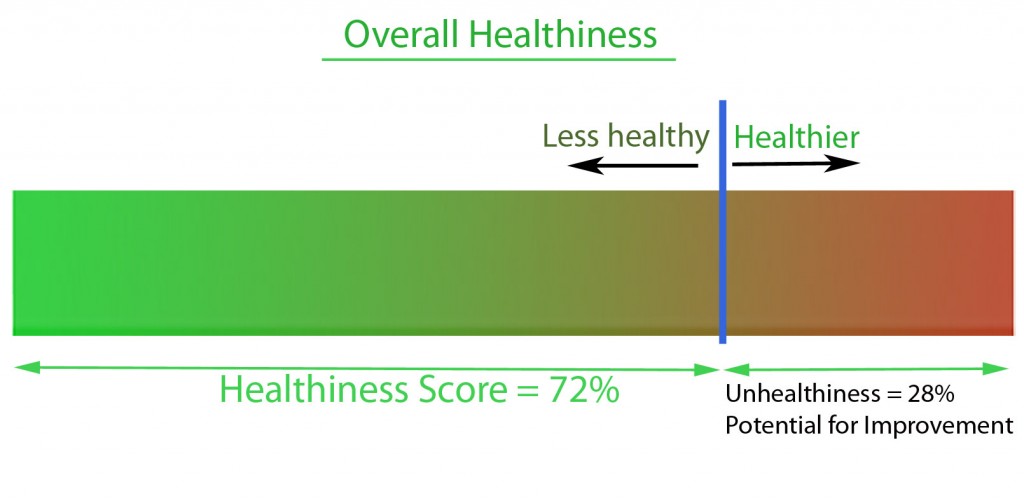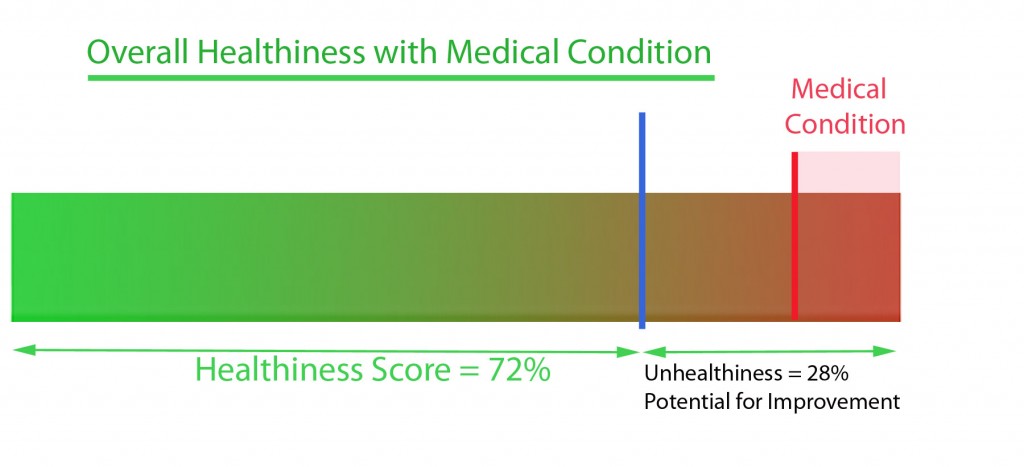What is wellness? How does ‘wellness’ relate to healthiness and illness? There are many definitions of wellness. In Healthicine we define wellness as the absence of disease. You are either ill, or you are well.
Wellness is not healthiness. Illness is not the opposite of healthiness. The inverse of healthiness is unhealthiness.

Each of us has a unique level of healthiness, as in the above diagram, where the level of healthiness is 72 percent. We each have some room to improve our healthiness. Room for improvement is our ‘unhealthiness’. As we grow healthier, unhealthiness shrinks. As we grow less healthy, healthiness shrinks, and unhealthiness grows.
What happens when we get sick?
You have a medical condition, when a doctor makes a diagnosis. A medical condition does not have a ‘percentage’ on your healthiness scale. It is either there, you have a diagnosis, or it is not there. Of course your medical condition might be mild, moderate, or severe, chronic or critical. It might be growing, or receding. It might be infectious or not.
When you get well again, your medical condition disappears, and you are back to the first image. The first image contains ‘wellness’, but you can’t “see” the absence of disease. Wellness is neither healthiness, nor unhealthiness, it is the absence of illness, the absence of a medical condition. Wellness does not imply any level of healthiness, or of unhealthiness, it is simply the absence of illness.
How can you attain wellness? First of all, you need to be sick. If you are not sick, you are well – and you have attained wellness. But, if you are sick, if you have a medical condition, there are two ways to achieve wellness.
There are two types of illness, thus two ways to attain wellness.
Type 1 illness is caused by an external agent. Bacteria, viruses, or a whack on the side of the head. To achieve wellness, you need to remove the external agent. Fight the bacteria, the virus, or run away from the person who is whacking you on the side of the head. Your disease will disappear, and your body will heal. You will be well. When you fight the illness cause, you remove from the Medical Condition and return to the status of the first diagram.
Type 2 illness is caused by your personal life choices, by unhealthiness. If your healthiness is 72, as in the first diagram, and you do many unhealthy things, your healthiness will drop, and an illness will creep in, as in this diagram.
If your illness, your absence of wellness is due to low healthiness, you can’t fight the illness. There is nothing to fight. The only way to deal with an illness that result from unhealthiness is to improve your healthiness. When you improve your healthiness, it will push the illness, the medical condition, off the top of the chart – and you will have attained wellness again.
Improving healthiness is the best preventative – of illness, the best way to maintain wellness. For many illnesses, improving healthiness is the only effective treatment. For all illnesses, improving healthiness will help you to recover faster and more completely.
Of course there’s a catch. It’s not always easy to tell if your illness is Type 1, illnesses that strike, or Type 2: an illness that results from sliding health. Some illnesses, cancer for example, might result from a strike (radiation, viruses, etc.) in some individual situations, and from sliding health – poor nutrition, crappy food, too much sunshine. Because cancer takes a long, long time to develop – medical doctors don’t bother to identify the specific cause, nor to distinguish between different types of cause.
You can fight back. Whether you have an illness that strikes, or an illness that slides into view, you can fight both with health. If you are healthier, illnesses that strike, colds, flu, even broken arms, pass more quickly. And if you are healthier, you are less likely to slide into illness.
The way to find wellness, and to maintain wellness, the absence of disease, is found in health.
To your health, tracy
——————————————————————————————————-
 This post is an expansion of the concepts presented in the book: Introduction to Healthicine, Theories of Healthiness, Unhealthiness, Illness and Aging.
This post is an expansion of the concepts presented in the book: Introduction to Healthicine, Theories of Healthiness, Unhealthiness, Illness and Aging.





I look at health as a continuum. At any point in time you need to know are your actions producing the results you want. If your goal if optimum health they you need a way to monitor your progress toward that goal on your health continuum. If your goal is taking personal control over the intervention use for eliminating a disease, you desperately need sensitive biochemical change information of the intervention effectiveness. Neither of these groups can rely on “how they fee” to provide the health information they need. The optimum health person may not have adverse symptoms to monitor and the person in need of healing can not equate “how they feel” to process of true healing.